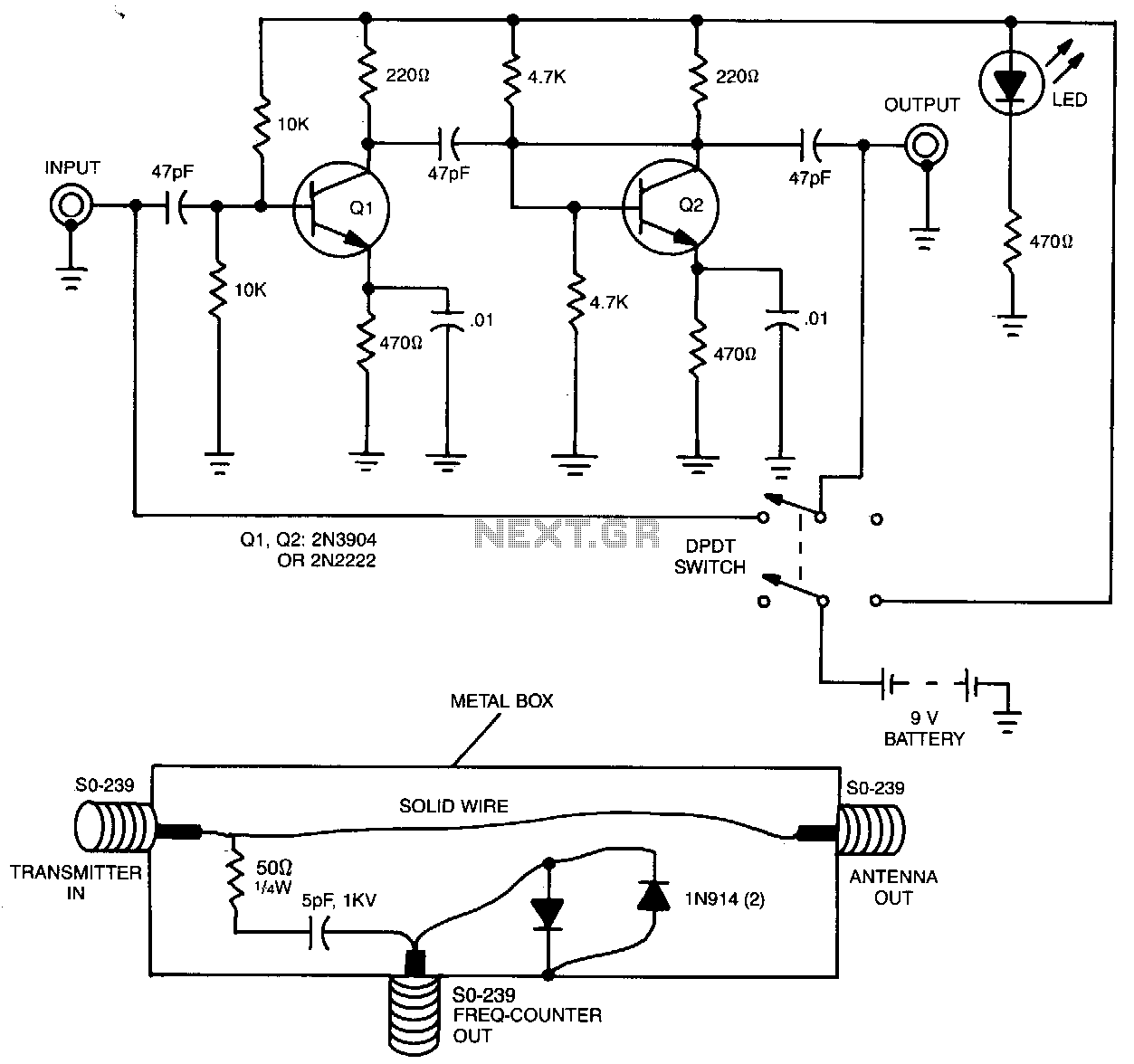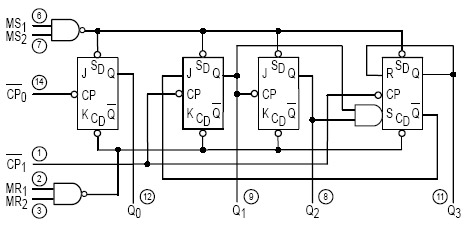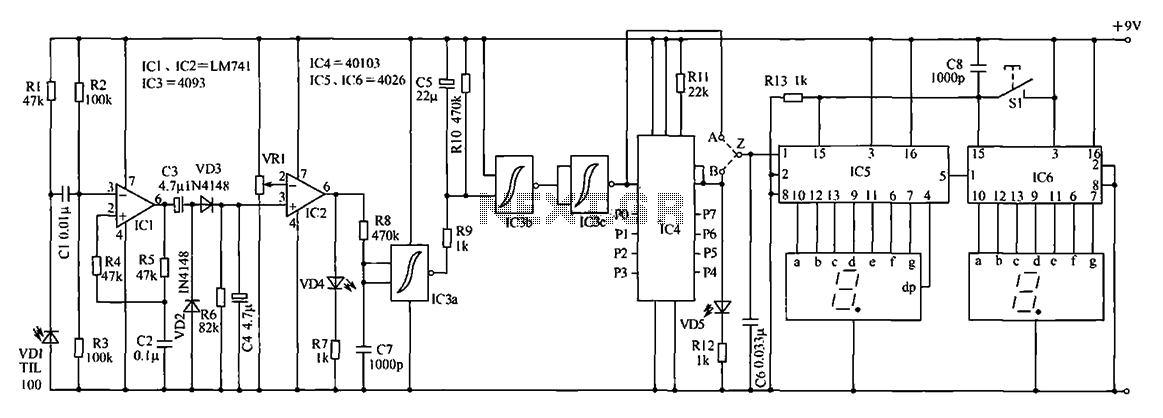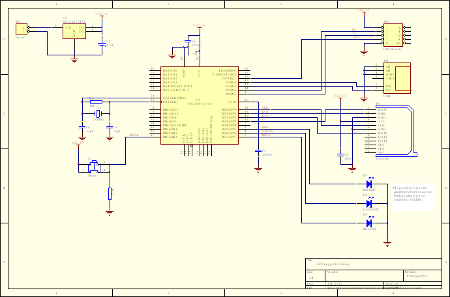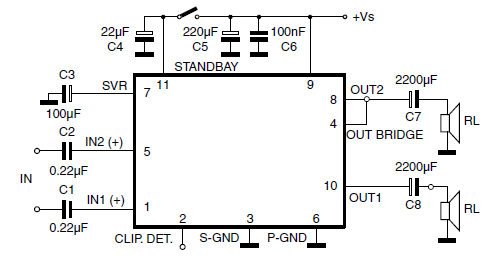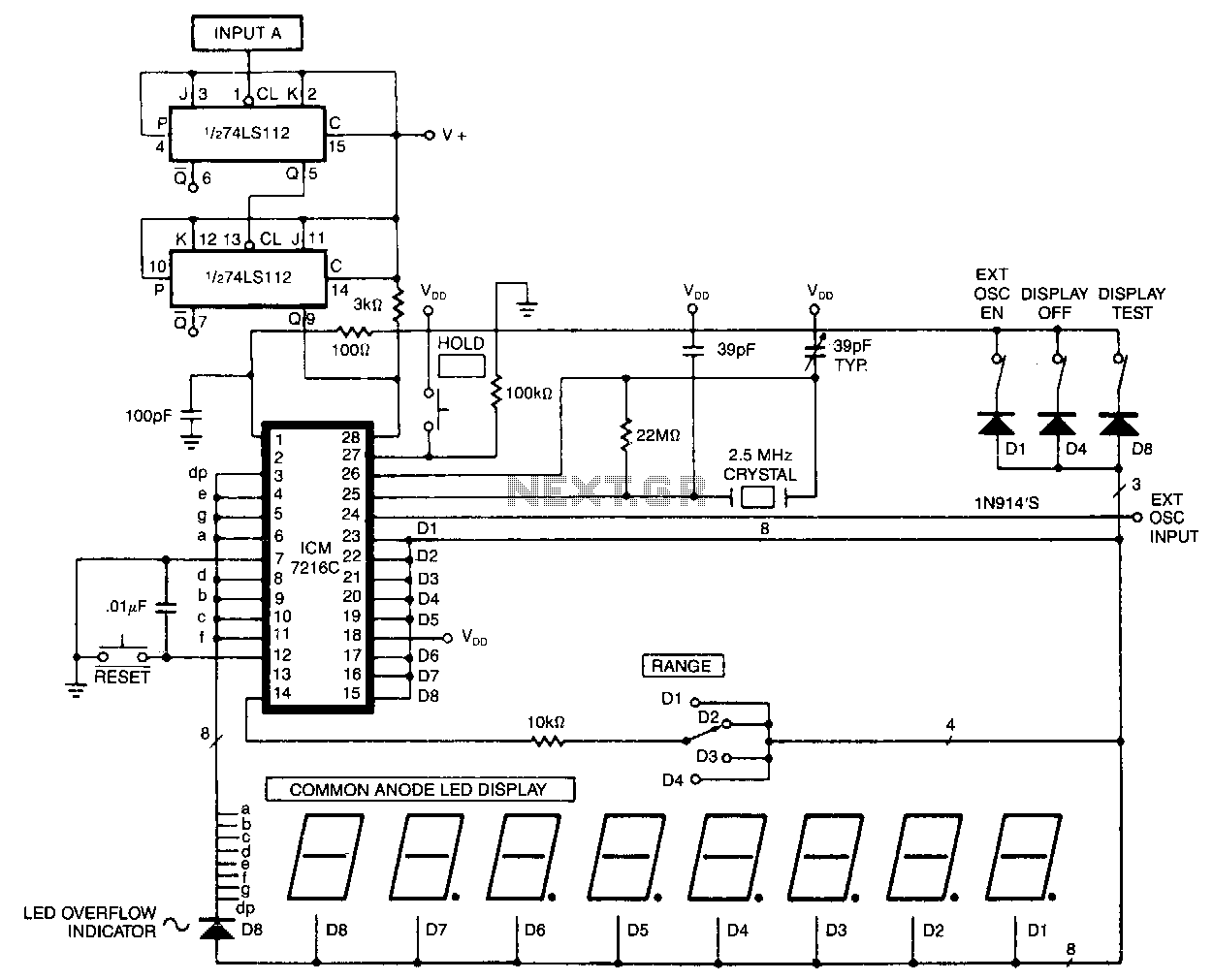
Geiger Counter Data Logger with LND712
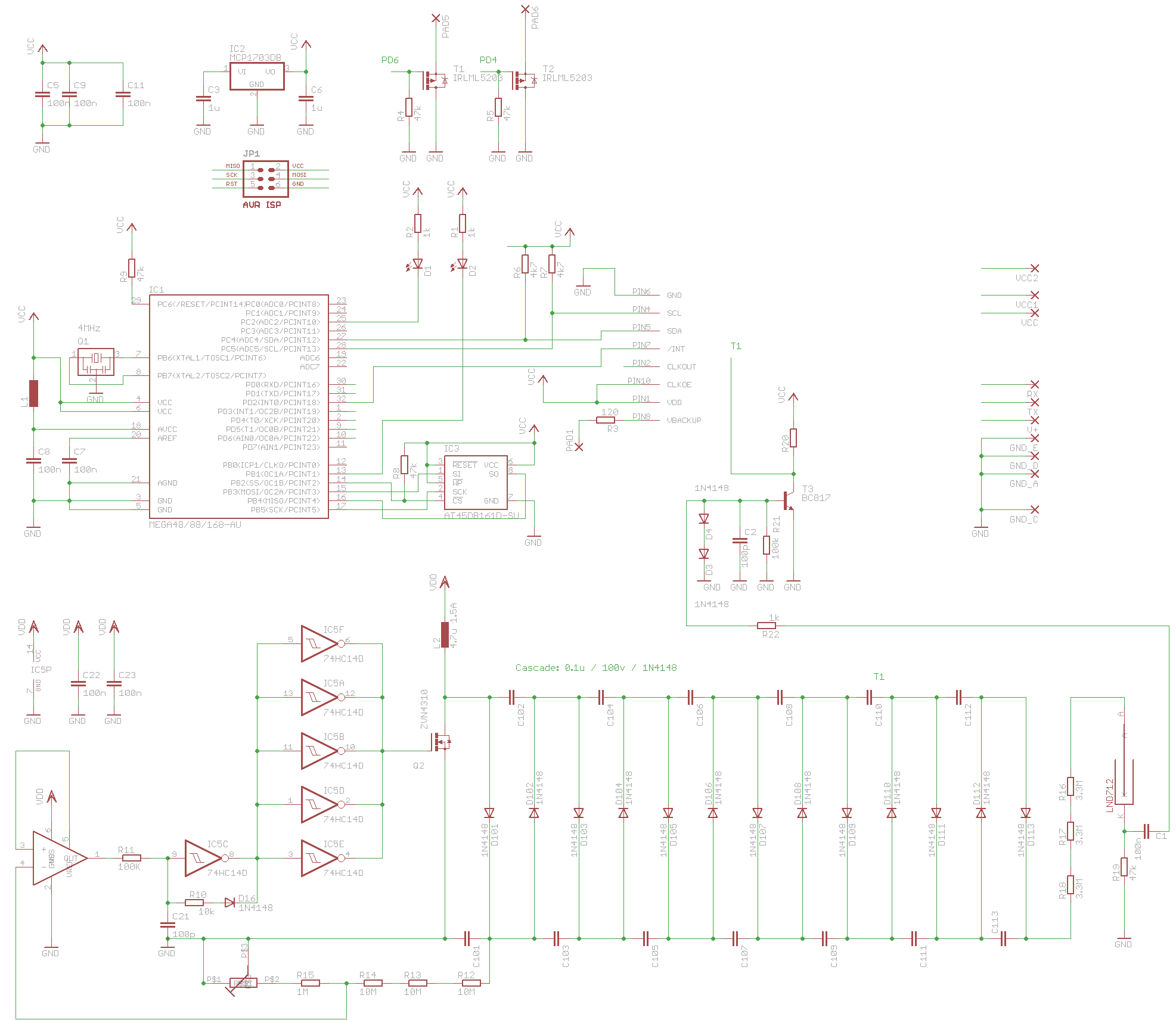
This circuit is designed for radiation logging purposes. It is based on an Atmel 168 Microcontroller and a precise RTC device called RV3029. An AT45DB41 Dataflash is utilized in this circuit, leveraging pre-existing source code for communication with this device. The design is compact and incorporates a modern LND712 counter tube, commonly used in commercial Geiger counters, which offers desirable alpha sensitivity. However, the cost of the tube is approximately 100 Euros. High voltage generation is achieved using a low-power circuit from an application note provided by Maxim, which operates efficiently, consuming only several microamperes. The onboard RTC provides flexible timing and alarm signals, with the Atmel external interrupts INT0 and INT1 connected to the RTC for this purpose. The circuit maintains low power consumption, particularly when utilizing the power reduction modes of the Atmel controller, potentially reducing consumption to several tens of microamperes. This makes the circuit well-suited for standalone long-term radiation measurement. Additional sensors can be connected via the I2C protocol, making this board a versatile platform for further development.
The circuit utilizes an Atmel ATmega168 microcontroller, which is a versatile 8-bit AVR device known for its low power consumption and robust performance in embedded applications. The RV3029 real-time clock (RTC) enhances the system's timing capabilities, providing precise timekeeping and alarm functionalities. This integration allows for scheduled measurements and data logging, essential for long-term radiation monitoring.
The AT45DB41 Dataflash memory serves as non-volatile storage, enabling the circuit to log radiation data over extended periods without power. The pre-existing communication protocol simplifies integration and reduces development time, as the necessary firmware for data handling is readily available.
The LND712 Geiger-Müller tube is a critical component, providing sensitivity to alpha particles and making it suitable for detecting various types of radiation. Despite its higher cost, the benefits of accurate and reliable radiation detection justify the investment for applications requiring precise measurements.
The high-voltage generation circuit, sourced from Maxim's application notes, is designed to be efficient and compact. This circuit is crucial for powering the Geiger tube, ensuring it operates within its specified voltage range while maintaining low power consumption. The overall design philosophy emphasizes minimal energy usage, allowing for prolonged operation on battery power.
The integration of external interrupts INT0 and INT1 from the Atmel microcontroller to the RTC allows for responsive event handling, enabling the circuit to react promptly to timing events or alarm conditions. This feature is particularly beneficial in applications where immediate response to radiation levels is necessary.
The circuit's low power operation, potentially as low as several tens of microamperes, is achieved through careful design choices, including the use of power reduction modes in the microcontroller. This characteristic is vital for applications requiring long-term deployment without frequent battery replacement.
Furthermore, the inclusion of I2C protocol support allows for easy expansion and integration of additional sensors, enhancing the circuit's functionality. This flexibility makes the design an excellent foundation for further innovation in radiation monitoring and related applications.Here is another little circuit I designed for radiation logging purposes. It is based on an Atmel 168 Microcontroller and a small and precise RTC device called RV3029. I also used an AT45DB41 Dataflash for this Circuit, as I had the sourcecode for communicating with this device already written. This is a very compact design that uses a modern LND7 12 counter Tube. This kind of tube is also widely used in modern commercial geiger counters, and its alpha sensitivity is also a very nice to have feature. The only drawback is its price, I paid around 100 Euros for it. The high voltage generation is done by a nice little circuit I found in an application note provided by Maxim.
It is a very efficient Low Power Design that only draws several microamperes. The onboard RTC can provide very flexible Timing and Alarm Signals, the Atmel external Interrupts INT0 and INT1 are connected to the RTC to make use of this feature. The power consumption of this circuit is very low when using the Power reduction modes of the Atmel controller.
Depending on your program, it can be as low as several 10 microamperes. So this circuit is ideally suited for standalone long term measuring of radiactivity. Other sensors can be easily connected by using the I2C protocol, so this board is also a very good starting point for your own Ideas. 🔗 External reference
The circuit utilizes an Atmel ATmega168 microcontroller, which is a versatile 8-bit AVR device known for its low power consumption and robust performance in embedded applications. The RV3029 real-time clock (RTC) enhances the system's timing capabilities, providing precise timekeeping and alarm functionalities. This integration allows for scheduled measurements and data logging, essential for long-term radiation monitoring.
The AT45DB41 Dataflash memory serves as non-volatile storage, enabling the circuit to log radiation data over extended periods without power. The pre-existing communication protocol simplifies integration and reduces development time, as the necessary firmware for data handling is readily available.
The LND712 Geiger-Müller tube is a critical component, providing sensitivity to alpha particles and making it suitable for detecting various types of radiation. Despite its higher cost, the benefits of accurate and reliable radiation detection justify the investment for applications requiring precise measurements.
The high-voltage generation circuit, sourced from Maxim's application notes, is designed to be efficient and compact. This circuit is crucial for powering the Geiger tube, ensuring it operates within its specified voltage range while maintaining low power consumption. The overall design philosophy emphasizes minimal energy usage, allowing for prolonged operation on battery power.
The integration of external interrupts INT0 and INT1 from the Atmel microcontroller to the RTC allows for responsive event handling, enabling the circuit to react promptly to timing events or alarm conditions. This feature is particularly beneficial in applications where immediate response to radiation levels is necessary.
The circuit's low power operation, potentially as low as several tens of microamperes, is achieved through careful design choices, including the use of power reduction modes in the microcontroller. This characteristic is vital for applications requiring long-term deployment without frequent battery replacement.
Furthermore, the inclusion of I2C protocol support allows for easy expansion and integration of additional sensors, enhancing the circuit's functionality. This flexibility makes the design an excellent foundation for further innovation in radiation monitoring and related applications.Here is another little circuit I designed for radiation logging purposes. It is based on an Atmel 168 Microcontroller and a small and precise RTC device called RV3029. I also used an AT45DB41 Dataflash for this Circuit, as I had the sourcecode for communicating with this device already written. This is a very compact design that uses a modern LND7 12 counter Tube. This kind of tube is also widely used in modern commercial geiger counters, and its alpha sensitivity is also a very nice to have feature. The only drawback is its price, I paid around 100 Euros for it. The high voltage generation is done by a nice little circuit I found in an application note provided by Maxim.
It is a very efficient Low Power Design that only draws several microamperes. The onboard RTC can provide very flexible Timing and Alarm Signals, the Atmel external Interrupts INT0 and INT1 are connected to the RTC to make use of this feature. The power consumption of this circuit is very low when using the Power reduction modes of the Atmel controller.
Depending on your program, it can be as low as several 10 microamperes. So this circuit is ideally suited for standalone long term measuring of radiactivity. Other sensors can be easily connected by using the I2C protocol, so this board is also a very good starting point for your own Ideas. 🔗 External reference
